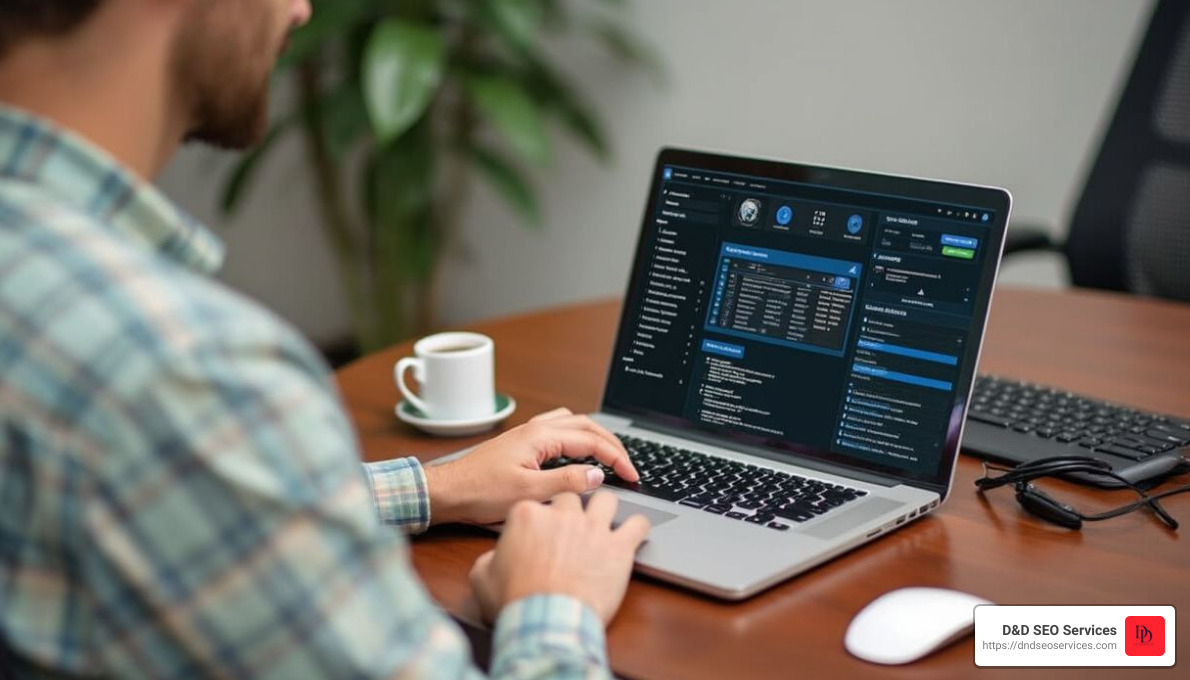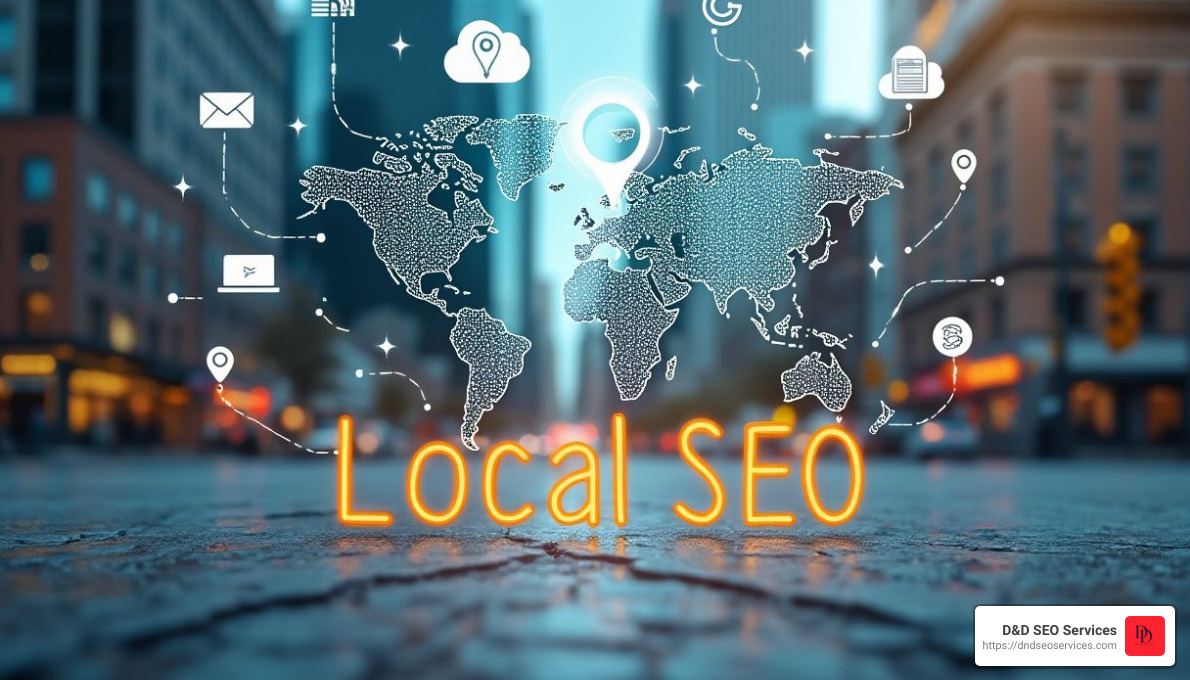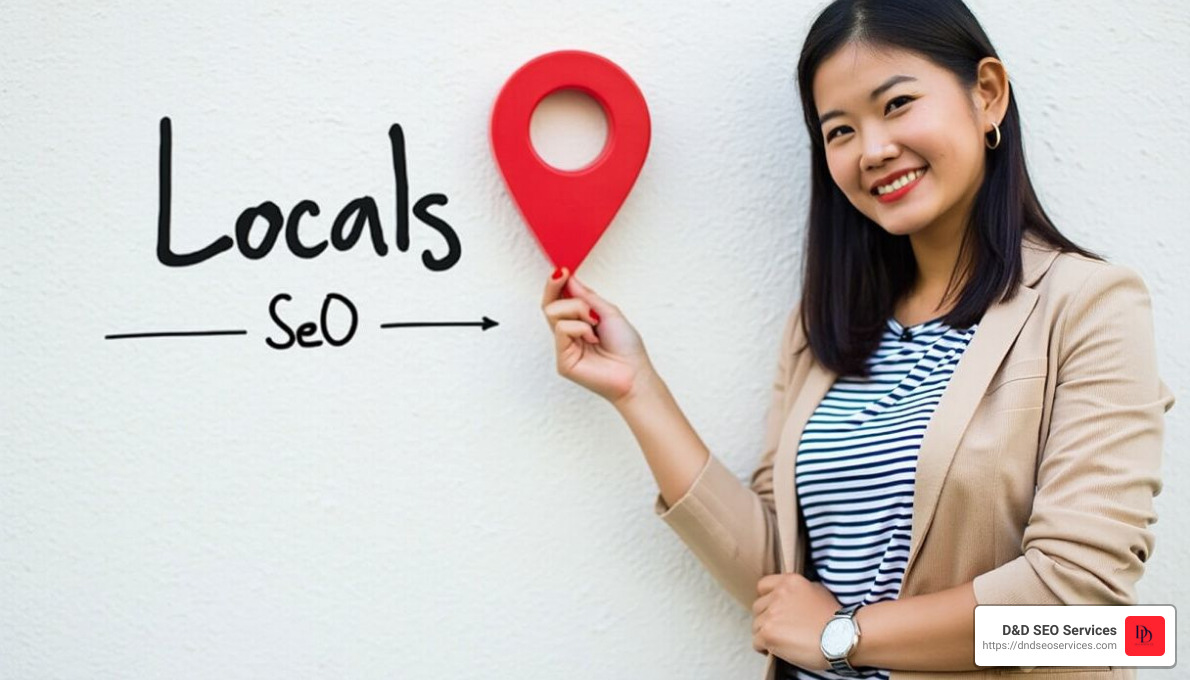Local SEO For Non-Physical Businesses: Overcoming The Challenges is a crucial topic for any business that does not have a physical location. The key challenges you’ll face include:
- Creating local visibility without a storefront
- Building citations and backlinks
- Optimizing Google My Business (GMB)
- Tracking SEO performance without local foot traffic
Imagine running a successful online business but struggling to attract local customers because you don’t have a physical address. It’s a unique challenge, but not an impossible one. Local SEO can help you gain visibility even if your business exists only online.
In this guide, we’ll explore how to optimize your online presence for local searches, even without a physical storefront. From creating local content to leveraging GMB, follow our steps to overcome these challenges and succeed.
I’m Danielle Birriel, founder and SEO visionary of D&D SEO Services. With over a decade of experience, I’ve specialized in helping businesses like yours conquer the nuances of local SEO, ensuring that you reach your audience effectively, no matter where they are.
Easy Local SEO For Non-Physical Businesses: Overcoming The Challenges glossary:
- local seo business listings
- local seo for contractors
- seo for local companies
Understanding Local SEO for Non-Physical Businesses
Local SEO helps businesses appear in search results for local queries. This is crucial for non-physical businesses that still want to attract local customers. Let’s break down how it works and why it’s important.
Local SEO and Online Visibility
Local SEO aims to increase your online visibility for searches in specific areas. This means when someone in your target geographical area searches for services you offer, your business shows up. For example, if you offer virtual fitness coaching in Denver, local SEO can help you appear in searches like “virtual fitness coach Denver.”
Target Geographical Area
Even without a physical location, you can still target specific areas. By using geo-specific keywords in your content, you signal to search engines that your business is relevant to those locations. For example, include phrases like “serving the Denver area” in your website copy.
Community Clientele
Engaging with the local community is also essential. Building a local clientele involves more than just appearing in search results. It means creating content that resonates with local issues and needs. For instance, if you’re a digital marketing consultant in Miami, write blog posts about “digital marketing trends in Miami.”
Practical Steps
1. Use Local Keywords: Incorporate city or neighborhood names into your content. This makes your business more relevant to local searches.
2. Create Location-Specific Content: Write blog posts, service pages, and success stories that address local issues. This can include topics like “Top Digital Marketing Challenges for Miami Startups.”
3. Encourage Local Reviews: Ask your customers to leave reviews on platforms like Google Business Profile, Yelp, and Facebook. Positive reviews from local clients can boost your credibility and visibility.
4. Use Google Business Profile: Even without a physical location, you can set up a Google Business Profile by specifying your service areas. This helps you appear in local search results and on Google Maps.
5. Network Locally: Partner with local businesses for link swapping and community events. This not only builds backlinks but also integrates you into the local community.
By following these steps, you can improve your local SEO, even without a physical storefront. Next, we’ll dive into the key challenges you might face and how to overcome them.
Key Challenges in Local SEO for Non-Physical Businesses
Navigating local SEO for non-physical businesses comes with its own set of problems. Here, we’ll address the main challenges and offer practical solutions to overcome them.
Lack of Physical Location
A challenge for non-physical businesses is the absence of a storefront. Search engines often prioritize businesses with a physical address in local search results. This can make it harder for service-area businesses to rank well.
Solution: Focus on optimizing your Google Business Profile (GBP) by specifying your service areas rather than a physical location. Ensure that your website content includes geo-specific keywords to signal relevance to those areas.
NAP Citations
NAP stands for Name, Address, and Phone Number. Consistency in NAP information across all online platforms is crucial for local SEO. However, non-physical businesses may find it tricky to manage this without a clear business address.
Solution: Use a consistent format for your NAP information wherever it’s listed online. Even if you don’t list a physical address, make sure your business name and phone number are identical across all directories and your website.
Google My Business
Setting up and maintaining a Google Business Profile can be challenging for non-physical businesses. Google’s guidelines are often more straightforward for brick-and-mortar businesses.
Solution: Configure your GBP correctly by specifying service areas instead of a physical location. According to Google’s guidelines, service-area businesses can have a profile as long as they make in-person contact with customers.
Customer Reviews
Customer reviews are a significant factor in local SEO rankings. However, non-physical businesses might struggle to collect reviews if customers don’t visit a physical location.
Solution: Actively solicit reviews through email campaigns, social media, and follow-up messages after services are rendered. Make it easy for customers to leave reviews by providing direct links to your GBP, Yelp, or other review platforms.
Example: A mobile car wash service in Memphis successfully increased their local SEO ranking by asking satisfied customers to leave reviews on their Google Business Profile.
By addressing these challenges, non-physical businesses can improve their local SEO and compete effectively in local search results. Next, we’ll explore how to optimize your website for local SEO.
Optimizing Your Website for Local SEO
Finding and Using Local Keywords
Local keywords are essential for improving your visibility in local searches. They help search engines understand where your business operates and who it serves.
Keyword Research
Start by conducting thorough keyword research. Tools like Google Keyword Planner, Ubersuggest, and Moz’s Keyword Explorer can help you find relevant local keywords. Focus on keywords with high search volume but low competition.
For instance, a pool maintenance service in Phoenix might target keywords like “pool cleaning Phoenix” or “Phoenix pool maintenance.” These keywords are specific and likely to attract local customers.
Incorporating Local Keywords
Once you have a list of local keywords, integrate them naturally into your website content. Use them in:
- Meta titles and descriptions
- Header tags (H1, H2, etc.)
- Body content
- Image alt texts
Example: A blog post titled “Top Challenges of Pool Maintenance in Phoenix’s Summer Heat” not only targets local keywords but also addresses issues specific to Phoenix pool owners.
Building Optimized Local Landing Pages
Creating localized landing pages is another powerful strategy for local SEO. These pages should be custom to each specific area you serve.
Localized Content
Each landing page should include content relevant to the local area. Mention local landmarks, community events, and address the unique needs of customers in that area.
For example, a roofing company serving both Chicago and Indianapolis should have separate landing pages for each city. The Chicago page might mention the harsh winters, while the Indianapolis page could focus on summer storms.
Customer Relevancy
Your landing pages should make it clear that your business is ingrained in the local community. Include:
- Local customer testimonials
- Case studies of projects completed in the area
- Region-specific offers or promotions
GMB Integration
Ensure your Google Business Profile (GBP) links to these localized landing pages. This boosts the relevance of your GBP listing for local searches.
Hyperlocal SEO
For businesses serving multiple neighborhoods within a city, hyperlocal SEO can be beneficial. Create landing pages for each neighborhood, focusing on hyper-specific keywords.
Example: A sandwich shop in Chicago’s Wrigleyville neighborhood might use keywords like “sandwich shop Wrigleyville” or “best lunch in Wrigleyville.”
Technical SEO and User Experience
Technical SEO and user experience are crucial for local SEO success. Here’s how to optimize these aspects:
Mobile-Friendly Design
With 88% of people searching for local businesses on mobile devices, having a mobile-friendly site is essential. A responsive design ensures your site looks great on all devices, improving user experience and reducing bounce rates.
Page Load Speed
Fast page load times are critical. Use tools like Google PageSpeed Insights to identify and fix issues slowing down your site. Slow-loading pages can frustrate users and lead to higher bounce rates.
Structured Data Markup
Use structured data markup, like Schema Markup, to help search engines understand your content better. For local businesses, this can include information like business hours, address, and customer reviews. This can improve your visibility in search results and even get you featured in rich snippets.
Core Web Vitals
Core Web Vitals are a set of metrics that measure user experience on your site. These include loading performance, interactivity, and visual stability. Improving these metrics can improve user satisfaction and boost your search rankings.
By focusing on these strategies, you can optimize your website for local SEO and attract more local customers. Next, we’ll dive into how to leverage Google My Business for non-physical businesses.
Leveraging Google My Business for Non-Physical Businesses
Claiming and Optimizing Your GMB Profile
For non-physical businesses, a Google Business Profile (GBP) is essential for local SEO success. Even if you don’t have a storefront, you can still create a robust GBP to improve your visibility and connect with local customers.
GMB Setup for Service Area Businesses
- Claim Your Business: First, search for your business on Google to see if a GBP already exists. If it does, claim it by following the verification steps. If not, create a new profile.
- Configure Service Area: As a service-area business, you don’t need to list a physical address. Instead, define your service area by city, zip code, or other regions. You can specify up to 20 different areas.
- Leave Business Location Blank: In the Business Profile Manager, leave the “business location” field blank under the Info tab. This is crucial for service-area businesses.
Optimizing Your GMB Profile
- Business Description: Write a clear and compelling description of your business. Include relevant keywords naturally to help users and search engines understand what you offer.
- Categories: Choose the most specific primary category that fits your business. Add secondary categories to cover all aspects of your services.
- Photos: Upload high-quality photos that showcase your work or services. Images with metadata from your service area can help Google verify your business’s legitimacy.
Example: A mobile car wash service might have photos of their team cleaning cars at various customer locations.
Generating and Managing Customer Reviews
Customer reviews are a critical component of local SEO. They build trust and can significantly impact your search rankings.
Review Solicitation
- Email Campaigns: Send follow-up emails to customers after a service, asking them to leave a review. Make it easy by including a direct link to your GBP review page.
- In-Store Reminders: If you have any physical interaction points, like delivery or on-site services, remind customers to leave a review. You could use business cards with a review request or a QR code that leads to your review page.
Example: A pool maintenance company might hand out cards with a QR code to customers after completing a service, encouraging them to leave a review.
Managing Reviews
- Auto Responses: Set up auto-responses to acknowledge new reviews promptly. This shows customers you value their feedback.
- Engage with Customers: Respond to reviews personally. Thank customers for positive reviews and address any issues mentioned in negative reviews. This engagement can improve your business’s reputation and customer satisfaction.
Review Platforms
Besides Google, encourage reviews on other platforms like Yelp and industry-specific directories. This diversifies your online presence and can help attract more local customers.
By focusing on these strategies, you can optimize your GBP and effectively manage customer reviews, enhancing your local SEO efforts. Next, we’ll explore how to build local citations and backlinks to further boost your online visibility.
Building Local Citations and Backlinks
Identifying Citation Opportunities
Local citations are mentions of your business’s name, address, and phone number (NAP) on the web. These citations help search engines verify your business’s location and boost your local SEO.
Where to Start:
- Local Directories: Ensure your business is listed on popular local directories like Yelp, Yellow Pages, and the Better Business Bureau. These sites are trusted by search engines and can help boost your visibility.
- Apple Maps and Bing Places: Don’t neglect these platforms. Many users rely on them for local searches. Listing your business here can help you reach more potential customers.
- Local Chamber of Commerce: Paying for a spot on your local chamber of commerce website is a great way to get a quality local link. These links are highly trusted and can significantly boost your local SEO.
Tools to Help:
- Whitespark and BrightLocal are excellent tools for finding citation sources relevant to your industry and area. They can help you track your citations and ensure NAP consistency across all platforms.
Effective Local Link Building Strategies
Building backlinks from local sources is crucial for demonstrating your website’s authority. Here’s how to get started:
1. Partner Links:
Leverage existing relationships with local businesses. For example, if you’re a bakery, partner with a local coffee shop for a special offer and get a link from their website.
2. Guest Posts:
Write articles for local blogs or news sites. Focus on topics relevant to your business and the community. Offer valuable content that naturally includes a link back to your website.
Example: A plumber could write a blog post about “Preparing Your Home for Winter in [City]” for a local news site, with a link back to their services.
3. Local Publications:
Reach out to local newspapers and magazines. If they’ve mentioned your business but didn’t include a link, ask them to add one.
4. Backlink Outreach:
Search for your brand name to see if any sites have mentioned you without linking. Reach out to these sites and request a backlink. Offer to write content or provide data in exchange for a link.
Quality Over Quantity:
Focus on getting links from reputable local sites rather than a large number of low-quality links. High-quality backlinks are more valuable and can significantly impact your SEO.
NAP Consistency:
Ensure your NAP information is consistent across all citations and backlinks. Inconsistent information can confuse search engines and hurt your rankings.
By focusing on these strategies, you’ll build a strong network of local citations and backlinks, further enhancing your local SEO efforts. Next, we’ll discuss how to track and measure your local SEO success.
Tracking and Measuring Local SEO Success
Setting Up a Tracking System
To know if your local SEO efforts are paying off, you need a robust tracking system in place. Here’s how to get started:
1. Google My Business Insights: This tool is invaluable for understanding how users interact with your GMB profile. Track metrics like search appearances, clicks, requests for directions, and phone calls.
2. Google Analytics: Set up Google Analytics to monitor website traffic, user behavior, and conversions. Pay special attention to traffic coming from local searches.
3. UTM Parameters: Use UTM parameters for the “Website” button on your GMB page. This helps track clicks and user behavior, providing insights into how visitors engage with your site from GMB.
4. Conversion Tracking: Implement conversion tracking to measure actions like form submissions, calls, or purchases. This data will help you understand the ROI of your local SEO efforts.
Analyzing and Adjusting Your Strategy
Once your tracking system is set up, regular analysis is crucial for continuous improvement.
1. Monthly Reports: Generate monthly reports to review key metrics. Look for trends in GMB insights, website traffic, and conversion rates.
2. Performance Analysis: Examine which local keywords are driving traffic and which landing pages are performing well. Identify any weak spots that need attention.
3. Strategy Adjustments: Use the insights from your analysis to adjust your strategy. For example, if a particular keyword isn’t performing, consider optimizing your content or building more backlinks for that term.
4. Continuous Improvement: Local SEO is an ongoing process. Regularly update your local citations, gather more reviews, and build new backlinks to stay ahead of the competition.
By following these steps, you can effectively track and measure your local SEO success, ensuring your strategy remains effective and up-to-date.
Frequently Asked Questions about Local SEO for Non-Physical Businesses
How does local SEO help small businesses?
Local SEO helps small businesses by improving online visibility in local search results, making it easier for potential customers to find you. Even if your business is non-physical, optimizing for local search can connect you with customers in your target geographical area.
For example, if you run a virtual tutoring service, local SEO can help you appear in searches like “online math tutor in Seattle.” This increases your chances of attracting customers from that location.
What is the best strategy for local SEO?
The best strategy for local SEO involves several key components:
1. Local Keywords: Start by conducting local keyword research to find terms that potential customers in your area are searching for. Tools like Google Keyword Planner can help you identify high-volume, low-competition keywords.
2. GMB Optimization: Make sure your Google My Business (GMB) profile is fully optimized. This includes filling out your business description, selecting the right categories, and adding high-quality photos.
3. Customer Reviews: Encourage satisfied customers to leave positive reviews on your GMB profile and other review platforms. Positive reviews boost your credibility and improve your local search rankings.
4. Backlinks: Build local backlinks by partnering with other local businesses, guest posting on local blogs, and getting listed in local directories. Quality backlinks signal to search engines that your business is trustworthy and relevant.
Should a service area business include their physical address on their Contact Us page?
This depends on several factors:
User Perspective: If your business operates from a residential address and customers will never visit, it might be best to leave the address off your Contact Us page. Instead, focus on providing clear contact information and service areas.
Residential Address: For service area businesses, listing a residential address can sometimes confuse customers. If your GMB profile is already verified and doesn’t show an address, it’s generally fine to omit it from your website.
NAP Consistency: Consistency in your Name, Address, and Phone Number (NAP) across all online platforms is crucial for local SEO. If you decide to include your address, make sure it matches exactly what’s listed on your GMB and other citations.
By addressing these frequently asked questions, you can better understand how to steer the challenges of local SEO for non-physical businesses and optimize your strategy for success.
Conclusion
At D&D SEO Services, we understand that local SEO for non-physical businesses comes with its own set of unique challenges. But with the right strategies and expert guidance, you can overcome these problems and achieve significant growth.
Personalized Strategies
Every business is unique, and so are its SEO needs. We offer personalized strategies custom to fit your specific requirements. Whether you’re a virtual tutoring service or an online consulting firm, our team will craft a plan that aligns with your business goals and target audience.
Local Market Expertise
Local SEO is more important than ever. According to our research, 97% of search engine users search online to find a local business. Our strategies are designed to help you dominate those local search results, ensuring that your business is easily found by potential customers in your area. From optimizing your Google Business Profile to building local citations, we make sure your business stands out.
Business Growth
Our ultimate goal is to drive business growth for our clients. We achieve this by focusing on both short-term wins and long-term strategies. Whether it’s through optimizing your website for conversions or implementing effective content marketing, we ensure that every aspect of your digital presence is fine-tuned for success.
Why Choose D&D SEO Services?
With over a decade of specialization in SEO and digital marketing, D&D SEO Services stands as a trusted partner for businesses looking to lift their online presence. Our comprehensive approach ensures that you not only reach your target audience but also engage and convert them.
Ready to open up the power of optimization techniques for your business? Contact us today to get started on your journey to online success!
By integrating these strategies, we help you create a stronger digital narrative that resonates with your audience, fostering growth and sustained customer relationships.










